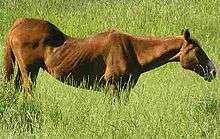Swayback
Swayback refers to abnormal bent-back postures in humans and in quadrupeds, especially horses.It can cause severe pain because of the straining of the muscles.
Sway Back Knees
Sway Back Knees is when the knees sit in the incorrect position on the leg. It causes the muscles around the knees to painfully contract all the time, especially during exercise. The muscles contract to try and keep the knee in place, and sometimes, when they get tired, the knee can lock and buckle and the knee won't be able to move. Sway Back Knees causes severe pain in the knee and surrounding muscles, especially during exercise. Most people with sway back knees struggle to do exercise and most don't do any at all because the pain is unbearable.
Humans
Swayback posture in humans is characterised by the posterior displacement of the rib cage in comparison to the pelvis. It looks like the person has a hyperextension of the natural lordosis, however this is not necessarily the case. Most sway-back exhibits a posteriorly tilted pelvis; the lumbar region is usually flat (too flexed) and not hyperlordotic (too extended).[1][2]
Horses

Usually called "swayback", soft back, or low back, an excessive downward bend in the back is an undesirable conformation trait. Swayback is caused in part from a loss of muscle tone in both the back and abdominal muscles, plus a weakening and stretching of the ligaments. As in humans, it may be influenced by bearing young; it is sometimes seen in a broodmare that has had multiple foals. However, it is also common in older horses whose age leads to loss of muscle tone and stretched ligaments. It also occurs due to overuse or injury to the muscles and ligaments from excess work or loads, or from premature work placed upon an immature animal. Equines with too long a back are more prone to the condition than those with a short back, but as a longer back is also linked to smoother gaits, the trait is sometimes encouraged by selective breeding. It has been found to have a hereditary basis in the American Saddlebred breed, transmitted via a recessive mode of inheritance. Research into the genetics underlying the condition has several values beyond just the Saddlebred breed as it may "serve as a model for investigating congenital skeletal deformities in horses and other species."[3]
See also
References
- ↑ "Sway back posture". lower-back-pain-management.com/. Retrieved 17 August 2014.
- ↑ Cressey, Eric. "Strategies for Correcting Bad Posture – Part 4". EricCressey.com. Retrieved 17 August 2014.
- ↑ Oke, Stacey. "Genetics of Swayback in Saddlebred Horses Examined" The Horse online edition, December 20, 2010. Accessed December 21, 2010